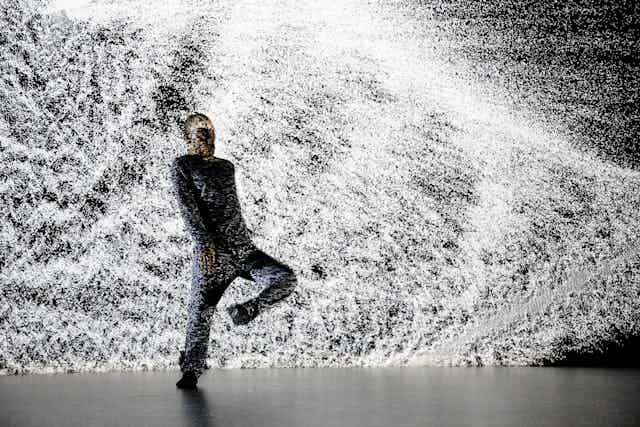The formal launch of the OzAsia Festival’s visual arts program at the Adelaide Festival Centre earlier this month involved an encounter with the unexpected.
In the adjoining gallery, instead of the usual well-heeled patrons and donors clinking wine glasses and devouring finger food, I saw men, women, and even children tossing off their shoes and jumping into Japanese choreographer Hiroaki Umeda’s immersive, pixelating video environment.

As projections of patterns swirled above, below and around them, two boys squealed with delight while seeming to bounce off the walls. A well-dressed woman improvised Isadora Duncan-inflected interpretive dance moves, their collective choreographies captured on mobile phones by friends and family members.
It was clear then that this Adelaide festival, now in its tenth year, was going to push the accepted boundaries of expression – not just for artists, but for audience members as well.
Australia’s only integrated annual arts festival focusing on Asian work runs this year from 17 September to 2 October, with its centrepiece, the performing arts programming, commencing on 21 September.
The second year of Festival Director Joseph Mitchell’s tenure offers nothing for the armchair traveller expecting the kind of generic Balinese dance one might encounter poolside at a resort. Instead, Adelaide will host a youthful and wide-ranging collection of contemporary visual arts and performance events from Asia and around the world.
The starting point seems to be that there is no line between “us” and “them,” and that contemporary Asian and Asian-influenced performance has its own confident sense of what it means to be modern that is both different from and enmeshed with the West.
Indeed, this festival reflects how in an interconnected world, the so-called “glo-cal,” which fuses the global with the local, is in fact the natural order behind virtually all artistic creation.
The result is likely to be a dynamic and joyful conversation about Australia’s location in Asia. This festival celebrates both our region, and the many people and cultures who have found a home in Australia.
Bringing in the young

This year’s festival seeks to further the event’s footprint by offering an expanded range of free events underwritten by a federal Catalyst grant.
Hong Kong’s super cool six piece fusion band SIU2, Korea’s wildly energetic and virtuosic psychedelic folk rock Danpyunsun and the Sailors, and the retro-hip Cambodia Space Project will be among the many must-see acts performing along the riverfront behind the Adelaide Festival Centre between 21 September and 1 October.
More importantly, it seems clear that this ambitious and expensive side-program is being pitched to the same youthful audience that underpins the vast Adelaide Fringe Festival. Like the Fringe, cool stuff will be happening in one place over a set period of time, with Asian street food available from the Good Fortune Market, an enterprise put together by the team that came up with the Fringe Festival’s wildly popular Croquet Club.
Though film and visual arts programs contribute meaningfully to the festival, it’s the performance program that draws in the largest number of audience members.
The big, family friendly opening night Moon Lantern Festival has in past years been troubled by the notoriously fickle mid September Adelaide weather, where arctic-like conditions have occasionally disrupted the festive mood. Not so this year as skies cleared for the lantern parade, and a long, steady stream of giant colourful, hand crafted paper lanterns gently lit up the night sky.

Ones to watch
Festival highlights this year are likely to include Hong Kong’s City Contemporary Dance Company’s As If to Nothing, and Japanese choreographer Hiroaki Umeda’s Split Flow and Holistic Strata, a high-octane, occasionally frantic interplay between the human form and an environment of moving projections, punctuated by electronic beats and low bass frequencies.
Cambodia’s low-tech, ingenious and transformative Phare Circus will perform in a tent outside the Festival Centre, while Malaysia’s Terryandthecuz will literally take audience members hostage.
Their work Skᴉn recreates the experience of refugees trapped in shipping containers, in highly differentiated, unpredictable journeys toward unknown destinations. The promotional materials for Skᴉn, ominously, advise audience members to dress warmly and carry valid identification.

The signature Gumby-like movement style developed by Japan’s Toshiki Okada and the Chelfitsch Theatre Company will be paired with a dramatic text interrogating Japan’s love of what is arguably America’s most significant cultural import, baseball, in God Bless Baseball. Meanwhile, the Theatre Company Mumbai will talk back to Shakespeare’s text in their energetic, highly physical staging of Twelfth Night.
In the weeks just prior to the festival, Mitchell came to speak to my students at Flinders University. He made it clear that he was courting their demographic, suggesting that many of the elements that drew them to the Fringe every year would be present at OzAsia.
The expanded use of social media and special events aimed at building a youth audience, coupled with a free Asian indie music festival, good eats, and a performance program that places contemporary Asian work centre stage, may well do the trick.

